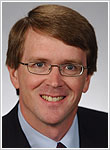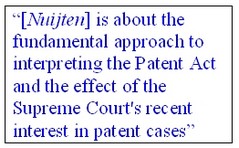
[PDF Version of this Post] In re Nuijten, which is being argued to the Federal Circuit today, presents the important issue of whether a new type of artificially constructed signal may be patented. The Patent and Trademark Office opposes patentability on the grounds that, as a matter of textual interpretation, signals do not fall within any one of the four categories of patentable subject matter - "process, machine, manufacture, or composition of matter" - identified in section 101 of the Patent Act. PTO Br. at 12 (quoting 35 U.S.C. § 101). Though Nuijten raises important issues concerning the scope of patentable subject matter under U.S. law (and that's reason enough for most patent practitioners and scholars to care about its outcome), the case is also about much more. It is about the fundamental approach to interpreting the Patent Act and the effect of the Supreme Court's recent interest in patent cases. To appreciate those larger issues, we must begin with a basic understanding of the facts at issue.

To continue reading, become a Patently-O member. Already a member? Simply log in to access the full post.